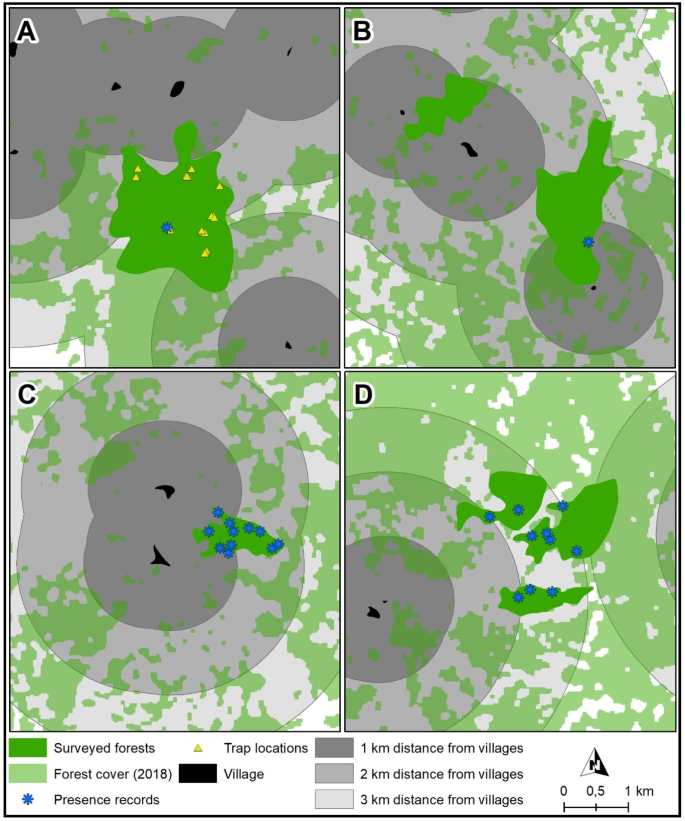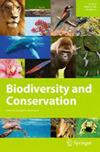Documentation of commercial and subsistence hunting of Critically Endangered black-and-white ruffed lemurs (Varecia variegata) in northeastern Madagascar
IF 3
2区 环境科学与生态学
Q1 BIODIVERSITY CONSERVATION
引用次数: 0
Abstract
Abstract Hunting of wild animals for meat and habitat loss are the main drivers of wildlife population decline around the world, and in tropical regions in particular. While Madagascar is a hotspot for biodiversity, hunting is widespread, mostly in form of subsistence hunting, while hunting for the pet trade is less often reported. We studied hunting of the Critically Endangered black-and-white ruffed lemur ( Varecia variegata ) in northeastern Madagascar. Using lemur surveys (102.7 km survey effort) and 54 semi-structured and seven key informant interviews, we assessed the local knowledge, hunting pressure, and the perceived and actual abundances of V. variegata in two hunting and two non-hunting villages. V. variegata was well known (> 83%) by the respondents but abundance estimates differed significantly between hunting and non-hunting villages, with 26% and 77% of respondents, respectively, estimating a high abundance of ruffed lemurs in the adjacent forests of the villages. Actual observations of V. variegata also differed strongly, in accordance to perceived abundances. Hunting was either done by trapping animals or by pursuit hunts. In both hunting villages, adult lemurs were used for direct meat consumption and juveniles for rearing for the later trade. Hand-raised V. variegata were reported to be sold for 38–71 USD on regional markets or ‘delivered’ directly to buyers. While wildlife hunting has been widely reported from all over Madagascar, commercial hunting, hand-rearing and trading adds a new dimension of threat towards these Critically Endangered lemurs. As such, the extent of the trade is a priority for future studies.

马达加斯加东北部极度濒危的黑白皱边狐猴(Varecia variegata)的商业和生存狩猎记录
以肉食为目的的野生动物狩猎和栖息地丧失是全球野生动物数量下降的主要驱动因素,特别是在热带地区。虽然马达加斯加是生物多样性的热点地区,但狩猎很普遍,主要是为了维持生计的狩猎,而为宠物贸易而狩猎的报道却很少。我们研究了马达加斯加东北部极度濒危的黑白皱毛狐猴(Varecia variegata)的狩猎。通过102.7 km的狐猴调查,54个半结构化访谈和7个关键信息访谈,我们评估了两个狩猎村和两个非狩猎村的狐猴知识、狩猎压力以及狐猴多样性的感知丰度和实际丰度。variegata是众所周知的(>(83%),但丰度估计值在狩猎村和非狩猎村之间存在显著差异,分别有26%和77%的受访者估计,在村庄邻近的森林中,皱褶狐猴的丰度很高。根据感知到的丰度,实际观察到的V. variegata也有很大的不同。狩猎要么是诱捕动物,要么是追捕猎物。在这两个狩猎村,成年狐猴被直接用于肉类消费,幼狐猴被用来饲养以供以后的贸易。据报道,人工饲养的V. variegata在区域市场上以38-71美元的价格出售,或者直接“交付”给买家。尽管马达加斯加各地广泛报道了野生动物狩猎,但商业狩猎、人工饲养和贸易给这些极度濒危的狐猴带来了新的威胁。因此,贸易的范围是未来研究的重点。
本文章由计算机程序翻译,如有差异,请以英文原文为准。
求助全文
约1分钟内获得全文
求助全文
来源期刊

Biodiversity and Conservation
环境科学-环境科学
CiteScore
6.20
自引率
5.90%
发文量
153
审稿时长
9-18 weeks
期刊介绍:
Biodiversity and Conservation is an international journal that publishes articles on all aspects of biological diversity-its description, analysis and conservation, and its controlled rational use by humankind. The scope of Biodiversity and Conservation is wide and multidisciplinary, and embraces all life-forms.
The journal presents research papers, as well as editorials, comments and research notes on biodiversity and conservation, and contributions dealing with the practicalities of conservation management, economic, social and political issues. The journal provides a forum for examining conflicts between sustainable development and human dependence on biodiversity in agriculture, environmental management and biotechnology, and encourages contributions from developing countries to promote broad global perspectives on matters of biodiversity and conservation.
 求助内容:
求助内容: 应助结果提醒方式:
应助结果提醒方式:


